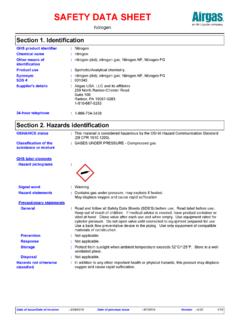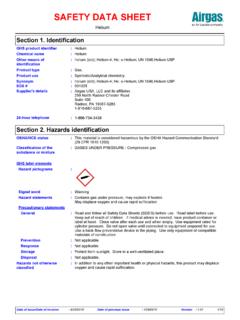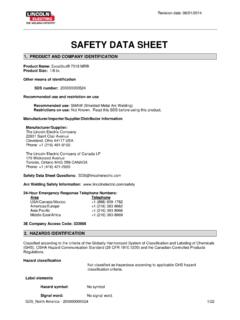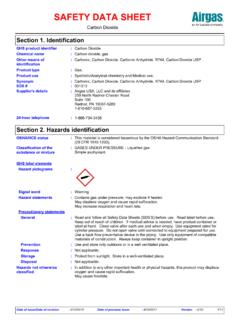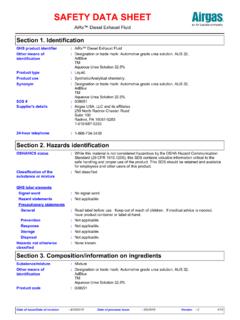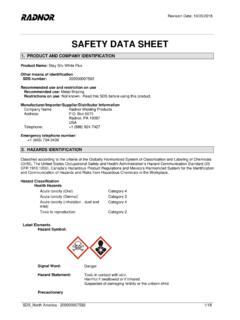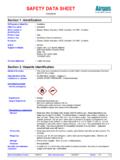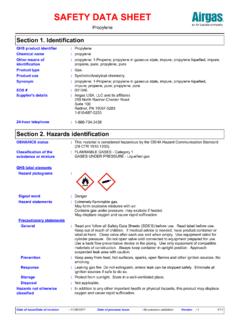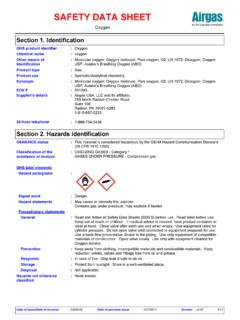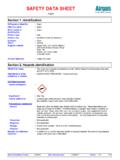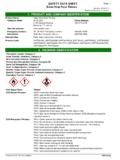Transcription of SAFETY DATA SHEET - Airgas
1 Nitrous OxideNitrogen oxide; Nitrous oxide; Laughing gas; Hyponitrous acid anhydride; Dinitrogen monoxide; NITROGEN OXIDE (N2O); FACTITIOUS AIR; Nitrogen monoxide;Hyponitrous data SHEETGHS product identifierOther means of identificationProduct typeSection 1. Identification:::Chemical name:Nitrous OxideSupplier's details:Nitrous OxideProduct use:Synthetic/Analytical :Nitrogen oxide; Nitrous oxide; Laughing gas; Hyponitrous acid anhydride; Dinitrogen monoxide; NITROGEN OXIDE (N2O); FACTITIOUS AIR; Nitrogen monoxide;Hyponitrous oxideSDS #:001042 Airgas USA, LLC and its affiliates259 North Radnor-Chester RoadSuite 100 Radnor, PA 19087-52831-610-687-52531-866-734-3438:2 4-hour telephoneSection 2. Hazards identificationOXIDIZING GASES - Category 1 GASES UNDER PRESSURE - Liquefied gasSPECIFIC TARGET ORGAN TOXICITY (SINGLE EXPOSURE) (Narcotic effects) -Category 3 Classification of the substance or mixture:Signal word:DangerHazard statements:May cause or intensify fire; gas under pressure; may explode if cause drowsiness or pictograms:Precautionary statementsPrevention:Keep away from clothing and other combustible materials.
2 Keep reduction valves,valves and fittings free from oil and grease. Use only outdoors or in a well-ventilated area. Avoid breathing :Call a POISON CENTER or doctor if you feel unwell. In case of fire: Stop leak if safe to do :Store locked up. Store in a well-ventilated place. Keep container tightly closed. Protect from label elementsGeneral:OSHA/HCS status:This material is considered hazardous by the OSHA Hazard Communication Standard (29 CFR ).May displace oxygen and cause rapid and follow all SAFETY data Sheets (SDS S) before use. Read label before out of reach of children. If medical advice is needed, have product container or label at hand. Close valve after each use and when empty. Use equipment rated for cylinder pressure. Do not open valve until connected to equipment prepared for a back flow preventative device in the piping. Use only equipment of compatible materials of construction. Open valve slowly. Use only with equipment cleaned for Oxygen service.
3 Always keep container in upright of issue/Date of revision:9/16/2021 Date of previous issue:9/13/2021 OxideSection 2. Hazards identificationDisposal:Dispose of contents and container in accordance with all local, regional, national and international not otherwise classified:In addition to any other important health or physical hazards, this product may displace oxygen and cause rapid 3. Composition/ information on ingredientsnitrous oxide10010024-97-2 Ingredient nameCAS number%There are no additional ingredients present which, within the current knowledge of the supplier and in the concentrations applicable, are classified as hazardous to health or the environment and hence require reporting in this name:Nitrous OxideOther means of identification:Nitrogen oxide; Nitrous oxide; Laughing gas; Hyponitrous acid anhydride; Dinitrogen monoxide; NITROGEN OXIDE (N2O); FACTITIOUS AIR; Nitrogen monoxide;Hyponitrous oxideCAS number:10024-97-2 Substance/mixtureCAS number/other identifiers:Occupational exposure limits, if available, are listed in Section concentration shown as a range is to protect confidentiality or is due to batch code:001042As this product is a gas, refer to the inhalation flush eyes with plenty of water, occasionally lifting the upper and lower eyelids.
4 Check for and remove any contact lenses. Continue to rinse for at least 10 minutes. Get medical contaminated skin with plenty of water. Remove contaminated clothing and shoes. Get medical attention if symptoms occur. Wash clothing before reuse. Clean shoes thoroughly before victim to fresh air and keep at rest in a position comfortable for breathing. If it is suspected that fumes are still present, the rescuer should wear an appropriate mask or self-contained breathing apparatus. If not breathing, if breathing is irregular or if respiratory arrest occurs, provide artificial respiration or oxygen by trained personnel. It may be dangerous to the person providing aid to give mouth-to-mouth medical attention. If necessary, call a poison center or physician. If unconscious,place in recovery position and get medical attention immediately. Maintain an open airway. Loosen tight clothing such as a collar, tie, belt or waistband. In case of inhalation of decomposition products in a fire, symptoms may be delayed.
5 The exposed person may need to be kept under medical surveillance for 48 4. First aid measuresEye contactSkin contactInhalationIngestion::::Descriptio n of necessary first aid measuresMost important symptoms/effects, acute and delayedInhalation:Can cause central nervous system (CNS) depression. May cause drowsiness or cause central nervous system (CNS) depression. As this product is a gas, refer to the inhalation section.:IngestionSkin contact:No known significant effects or critical known significant effects or critical hazards.:Eye contactOver-exposure signs/symptomsPotential acute health effectsFrostbite:Try to warm up the frozen tissues and seek medical of issue/Date of revision:9/16/2021 Date of previous issue:9/13/2021 OxideSection 4. First aid measuresProtection of first-aiders:No action shall be taken involving any personal risk or without suitable training. If it is suspected that fumes are still present, the rescuer should wear an appropriate mask or self-contained breathing apparatus.
6 It may be dangerous to the person providing aid to give mouth-to-mouth to physician:In case of inhalation of decomposition products in a fire, symptoms may be exposed person may need to be kept under medical surveillance for 48 treatments:No specific contactIngestionInhalationAdverse symptoms may include the following:, nausea or vomiting, headache,drowsiness/fatigue, dizziness/vertigo, unconsciousnessNo specific specific data .:::Eye contact:No specific toxicological information (Section 11)Indication of immediate medical attention and special treatment needed, if necessarySection 5. Fire-fighting measuresPromptly isolate the scene by removing all persons from the vicinity of the incident if there is a fire. No action shall be taken involving any personal risk or without suitable training. Contact supplier immediately for specialist advice. Move containers from fire area if this can be done without risk. Use water spray to keep fire-exposed containers cool. If involved in fire, shut off flow immediately if it can be done without thermal decomposition productsSpecific hazards arising from the chemicalDecomposition products may include the following materials:nitrogen oxidesContains gas under pressure.
7 Oxidizing material. This material increases the risk of fire and may aid combustion. Contact with combustible material may cause fire. In a fire or if heated, a pressure increase will occur and the container may burst or should wear appropriate protective equipment and self-contained breathing apparatus (SCBA) with a full face-piece operated in positive pressure protective equipment for fire-fightersUse an extinguishing agent suitable for the surrounding media:::None extinguishing media:Unsuitable extinguishing media:Special protective actions for fire-fighters:Section 6. Accidental release measuresEnvironmental precautionsPersonal precautions, protective equipment and emergency procedures::No action shall be taken involving any personal risk or without suitable surrounding areas. Keep unnecessary and unprotected personnel from entering. Shut off all ignition sources. No flares, smoking or flames in hazard breathing gas. Provide adequate ventilation. Wear appropriate respirator when ventilation is inadequate.
8 Put on appropriate personal protective emergency procedures to deal with accidental gas releases are in place to avoid contamination of the environment. Inform the relevant authorities if the product has caused environmental pollution (sewers, waterways, soil or air).Methods and materials for containment and cleaning upFor non-emergency personnelFor emergency responders:If specialized clothing is required to deal with the spillage, take note of any information in Section 8 on suitable and unsuitable materials. See also the information in "For non-emergency personnel".Date of issue/Date of revision:9/16/2021 Date of previous issue:9/13/2021 OxideSection 6. Accidental release measuresImmediately contact emergency personnel. Stop leak if without risk. Use spark-proof tools and explosion-proof equipment. Note: see Section 1 for emergency contact information and Section 13 for waste spill:Immediately contact emergency personnel. Stop leak if without risk. Use spark-proof tools and explosion-proof spill:Section 7.
9 Handling and storageAdvice on general occupational hygieneConditions for safe storage,including any incompatibilitiesEating, drinking and smoking should be prohibited in areas where this material is handled, stored and processed. Workers should wash hands and face before eating,drinking and smoking . Remove contaminated clothing and protective equipment before entering eating areas. See also Section 8 for additional information on hygiene in accordance with local regulations. Store in a segregated and approved away from direct sunlight in a dry, cool and well-ventilated area, away from incompatible materials (see Section 10). Cylinders should be stored upright, with valve protection cap in place, and firmly secured to prevent falling or being knocked temperatures should not exceed 52 C (125 F). Store locked up. Separate from reducing agents and combustible materials. Store away from grease and container tightly closed and sealed until ready for use. See Section 10 for incompatible materials before handling or use.
10 ::Protective measuresPut on appropriate personal protective equipment (see Section 8). Contains gas under pressure. Avoid breathing gas. Use only with adequate ventilation. Wear appropriate respirator when ventilation is inadequate. Do not puncture or incinerate container. Use equipment rated for cylinder pressure. Close valve after each use and when cylinders from physical damage; do not drag, roll, slide, or drop. Use a suitable hand truck for cylinder movement. Avoid contact with eyes, skin and clothing. Empty containers retain product residue and can be hazardous. Keep away from clothing, incompatible materials and combustible materials. Keep reduction valves free from grease and oil.:Precautions for safe handlingnitrous oxideACGIH TLV (United States, 3/2019). TWA: 90 mg/m 8 hours. TWA: 50 ppm 8 REL (United States, 10/2016). TWA: 46 mg/m 10 hours. TWA: 25 ppm 10 8. Exposure controls/personal protectionIngredient nameExposure limitsEnvironmental exposure controls:Emissions from ventilation or work process equipment should be checked to ensure they comply with the requirements of environmental protection legislation.
